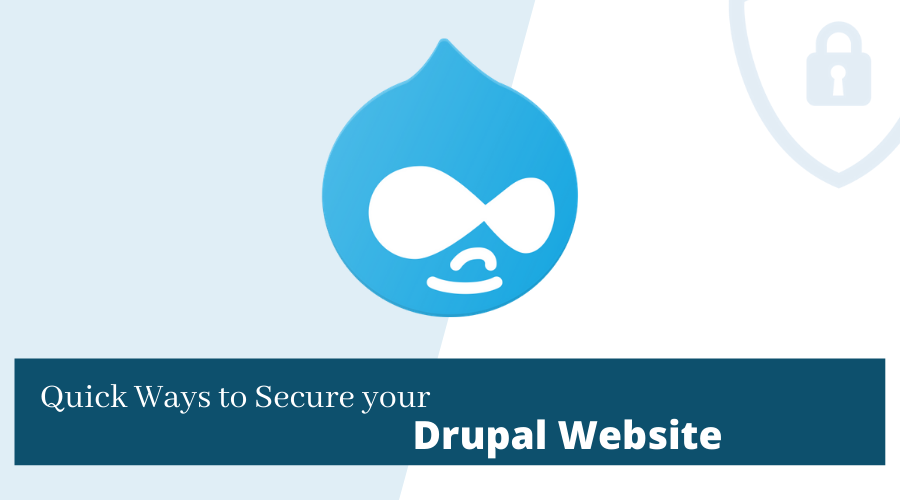Drupal is a popular and widely embraced CMS due to its high-end security. But because hackers pose a high threat worldwide, it becomes difficult to sustain website security. This blog will provide 10 best practices to secure the sensitive data on your Drupal site.
Drupal is an open-source CMS well-known for its stability and excellent security standards. With creating a high-quality and glitch-free website, Drupal is one of the leading platforms. As per Website Builder, there are 1.6% of all websites run on Drupal, as of Feb’ 2020, there are 0.56 million live Drupal sites. Also, Drupal has a 2.9% share of the CMS market.
Being the most secure CMS and application framework, Drupal holds a premier reputation when it comes to online security. With protecting private and confidential data, Drupal is always made safe by the leading Drupal experts. With many such traits, Drupal is well-secured and beats the prominent market players.
Top 10 Best Practices for Drupal Security – Proven Security Checklists
Keep Drupal Core and Modules Updated
An updated version of your Drupal site not only keeps your Drupal site secure, but it is also one of the most effective ways to keep the hackers away from your site. It is strongly recommended to use advanced Drupal modules and themes, and apply security patches as soon as they get released – you can download the latest version of Drupal here.
Doing this will lock any security gaps in your Drupal website and stop any identified vulnerability from keeping your Drupal site secure.
Use Drupal Security Modules
Drupal Security modules are specially created to keep your Drupal site shielded from the attacks of cybercriminals. There are various security modules available that allow you to block malicious networks, security threats, scan from vulnerabilities, and more.
Vigorous Drupal security modules work as a powerful tool to strengthen the protection of your Drupal site and helps in sustaining the security of your Drupal website.
Strengthen Your Username and Password
Do you have a smart username and password for your Drupal site? Do you keep changing them with time to prevent any brute-force cyber attack on your website? If not, then you should start counting this as one of the most significant ways to harden your Drupal security.
To avoid any cyber threat, you must generate a ‘hard-nut-to-crack’ type of login credentials for your Drupal site. Including letters, uppercase/lowercase, symbols, and characters, in your credentials, can make your username and password stronger than you can ever imagine.
Create a Strong Website Backup
It is always recommended to backup your website to maintain high-end security. Regular backup of your Drupal site allows you to rollback if you are attacked easily and restore your CMS. Also, it is must-advised to always back up your files and MySQL database before running any update on your Drupal code and modules. This comes under one of the vital security checklists that should be included in the best practices for Drupal security.
Choose a Reliable Hosting Provider
Choosing a reliable hosting provider is considered to be one of the best practices for keeping your Drupal site well-secure. Always make sure to select a server that supports and goes well with the latest Drupal version.
Opting for a trustworthy and reputable hosting provider is essential because you never know whether the other websites share the same hosting server with you or not, and you might lose your sensitive and crucial data. A highly-skilled and experienced hosting provider will fix all the glitches of your Drupal website.
Always Use Secure Connections
Ensuring the connections you are using is secure is also a significant step towards Drupal security. It is suggested to use SFTP or SSH encryption if your web host provides. It is also crucial to make sure that your firewall rules are set up correctly on your home router as it is a trusted network that will prevent your Drupal site from any cyber attack.
Enable HTTP Secure (HTTPS)
Irrespective of your website niche, it is always recommended to back your website with an SSL certificate and HTTPS connection because every site has some private and confidential data that owners can’t afford to lose.
If your website is not running over an HTTPS connection, your username and password are always sent in clear text over the internet. That’s why enabling HTTPS becomes one of the most significant components for your Drupal site security.
Check File Permissions
It is essential to ensure and use the correct file permissions if you want to keep your Drupal site secure. Each directory and file contain different permissions that allow people to access them. Loose file permissions allow intruders to attack your website. Therefore, make sure you are using correct file permissions on your Drupal site to avoid any brute-force cyber attack.
Block Access to Sensitive Files
You can limit or even block the access to some of your sensitive files such as upgrade.php., install.php, authorize.php, cron.php if you don’t want others to access these files. Configuring your .htaccess allows you to do that easily. All you need to do is to specify the IP address allotted to access those folders, data, and subdomains.
Database Security
There are other things as well apart from checking file permissions and restricting access to sensitive files that harden the security on your Drupal database. Using table prefix is highly-recommended out of all, if you change it to something like this – x5sdf_, it will be difficult for any hacker to get into your Drupal site.
Summing Up
Keeping your Drupal site safe sounded as an arduous task in the beginning, but now as you can see, there are several ways mentioned above that you can apply to harden your Drupal security. From updating modules, powering up username and password, reliable backup, using secure connections to database security, these recommendations will help you in keeping your Drupal site safe and secure.











